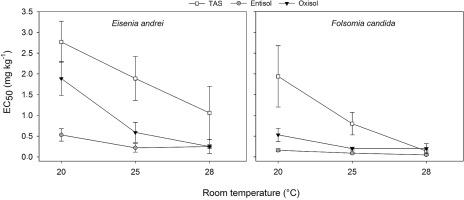Environmental Pollution ( IF 7.6 ) Pub Date : 2020-08-31 , DOI: 10.1016/j.envpol.2020.115565 Felipe Ogliari Bandeira , Paulo Roger Lopes Alves , Thuanne Braúlio Hennig , Tânia Toniolo , Tiago Natal-da-Luz , Dilmar Baretta

|
The influence of temperature on the chronic toxicity and risk of imidacloprid to soil non-target species was assessed in tropical soils. Earthworms Eisenia andrei and collembolans Folsomia candida were exposed to a tropical artificial soil (TAS) and two natural tropical soils from Brazil (Entisol and Oxisol) with increasing concentrations of imidacloprid under atmospheric temperatures of 20, 25 and 28 °C. The effect of temperature on the reproduction of both species was assessed through the number of juveniles and earthworm’s growth, and the risk associated was estimated through the Toxicity-Exposure Ratio (TER). Toxicity of imidacloprid increased with temperature in all tested soils, being generally lower in TAS soil (EC50s of 1.48, 0.66 and 0.40 mg kg-1 for E. andrei and 0.3, 0.2 and 0.06 mg kg-1 for F. candida at 20, 25 and 28ºC, respectively) compared to Entisol (EC50s of 0.19, 0.03 and 0.14 mg kg-1 for E. andrei and 0.04, 0.02, 0.01 mg kg-1 for F. candida at 20, 25 and 28 ºC, respectively) and Oxisol (EC50s of 0.21, 0.07, 0.06 mg kg-1 for E. andrei and 0.16, 0.09, 0.06 mg kg-1 for F. candida at 20, 25 and 28 ºC, respectively) within each temperature for both species. These values indicate that properties of TAS may not be representative of natural/local soils to adequately estimate the toxicity of pesticides to non-target soil species. At higher temperatures, the variability of imidacloprid toxicity between soils was lower, which suggests that the influence of soil properties on imidacloprid toxicity was overshadowed by temperature. TER values revealed that risk is also greater at higher temperatures. Data reported enforce the need for the inclusion of more realistic conditions in single-species tests in prospective risk assessment of pesticides to avoid underestimation of risk to non-target species.
中文翻译:

温度对吡虫啉的毒性效果赤子爱胜安德烈和Folsomia念珠菌在热带土壤
在热带土壤中评估了温度对吡虫啉对土壤非目标物种的慢性毒性和风险的影响。蚯蚓赤子安德烈和跳虫Folsomia念珠菌暴露于热带人造土壤(TAS)和来自巴西(Entisol和Oxisol)两种天然热带土壤与下的20,25和28°C大气温度增加吡虫啉浓度。温度对两个物种繁殖的影响通过幼虫数量和earth的生长来评估,而相关的风险则通过毒性-暴露比(TER)进行评估。在所有测试土壤中,吡虫啉的毒性均随温度升高而增加,在TAS土壤中一般较低(EC 50 s为1.48、0.66和0.40 mg kg-1用于E.安德烈和0.3,0.2和0.06毫克千克-1为F.念珠菌在20,25和28ºC,分别地)相比Entisol(EC 50个小号0.19,0.03和0.14毫克千克-1为E.安德烈和0.04,0.02,0.01毫克千克-1为F.念珠菌在20,25和28ºC,分别地)和Oxisol(EC 50个小号0.21,0.07,0.06毫克公斤-1为E.安德烈和0.16,0.09,0.06毫克千克-1为F.念珠菌两个物种在每个温度下分别处于20、25和28℃的温度下)。这些值表明,TAS的特性可能无法代表天然/本地土壤,无法充分估计农药对非目标土壤物种的毒性。在较高温度下,土壤间吡虫啉毒性的变异性较低,这表明土壤性质对吡虫啉毒性的影响被温度所掩盖。TER值表明,较高温度下的风险也更大。所报告的数据强制要求在农药的前瞻性风险评估中将更现实的条件纳入单一物种测试中,以避免低估非目标物种的风险。































 京公网安备 11010802027423号
京公网安备 11010802027423号